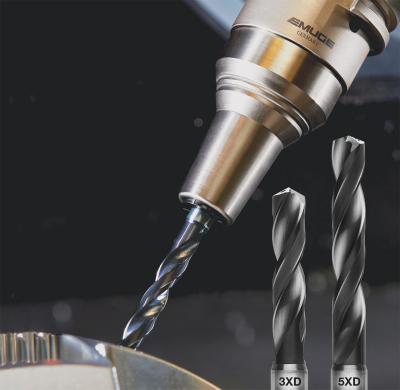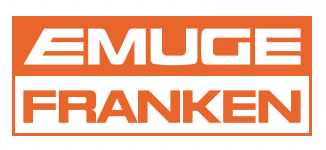
Today, EMUGE-FRANKEN USA, a leading manufacturer of high-performance taps, thread mills, end mills, drills, and other rotary tools, has introduced a full line of 3XD and 5XD high quality solid carbide multipurpose drills that are ideal for a wide range of materials and applications typically found in high mix – low volume job shop environments.
“Our extensive research and testing has resulted in a completely new high penetration rate drill design providing everyday use and maximum productivity,” said Marlon Blandon, Product Manager, Drills, Thread Milling.
EMUGE MultiDRILL™ is made of a unique sub-micro grain carbide grade that is harder than conventional carbide grades for drilling, yet it retains the ability to withstand shock and chipping. MultiDRILL features advanced TIALN-T63 coating utilizing nano-layer technology with surface hardness exceeding standard TIALN-based coatings, for reduced friction at high temperatures.
Featuring concave cutting edges, MultiDRILL has higher chip shearing ability and a tightly controlled edge preparation process that provides consistent performance and long tool life. In addition, a double margin design helps stabilize the drill in the cut, allowing rounder, more accurate holes. Another unique MultiDRILL feature is a drill web construction with a wide open flute form for maximum chip evacuation. MultiDRILLs are also self-centering, eliminating pre-spot drilling applications, and all tools feature coolant-thru capability.
EMUGE MultiDRILL is available in 3XD and 5XD sizes from 0.1181 to 0.7500 inch, a total of 372 SKUs in the program.
Contact Details
Related Glossary Terms
- edge preparation
edge preparation
Conditioning of the cutting edge, such as a honing or chamfering, to make it stronger and less susceptible to chipping. A chamfer is a bevel on the tool’s cutting edge; the angle is measured from the cutting face downward and generally varies from 25° to 45°. Honing is the process of rounding or blunting the cutting edge with abrasives, either manually or mechanically.
- gang cutting ( milling)
gang cutting ( milling)
Machining with several cutters mounted on a single arbor, generally for simultaneous cutting.
- hardness
hardness
Hardness is a measure of the resistance of a material to surface indentation or abrasion. There is no absolute scale for hardness. In order to express hardness quantitatively, each type of test has its own scale, which defines hardness. Indentation hardness obtained through static methods is measured by Brinell, Rockwell, Vickers and Knoop tests. Hardness without indentation is measured by a dynamic method, known as the Scleroscope test.
- milling
milling
Machining operation in which metal or other material is removed by applying power to a rotating cutter. In vertical milling, the cutting tool is mounted vertically on the spindle. In horizontal milling, the cutting tool is mounted horizontally, either directly on the spindle or on an arbor. Horizontal milling is further broken down into conventional milling, where the cutter rotates opposite the direction of feed, or “up” into the workpiece; and climb milling, where the cutter rotates in the direction of feed, or “down” into the workpiece. Milling operations include plane or surface milling, endmilling, facemilling, angle milling, form milling and profiling.
- web
web
On a rotating tool, the portion of the tool body that joins the lands. Web is thicker at the shank end, relative to the point end, providing maximum torsional strength.

